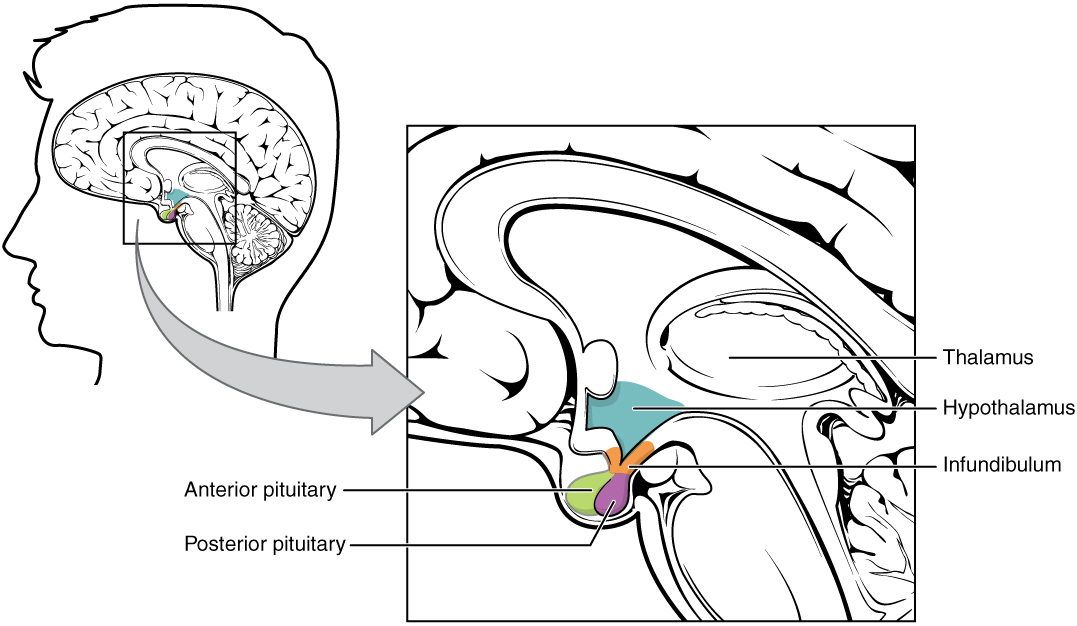Playlist
Show Playlist
Hide Playlist
Pituitary Gland: Anterior and Posterior Lobe
-
Slides 04 Human Organ Systems Meyer.pdf
-
Reference List Histology.pdf
-
Download Lecture Overview
00:00 at the anterior pituitary in a bit more detail. On the left hand side are these very pretty cells, stained, either acidophils or basophils. And as we’ll see in a moment, different cells types are within these two types of stained cells, and they secrete different hormonal products. 00:26 Those orange-shaped structures you see or colored structures you see in the section are actually blood vessels, blood capillaries. It’s a pituitary gland, both the anterior pituitary and the posterior pituitary being an endocrine gland rather, are extremely vascular as you’d expect because those blood vessels take away the secretory product. 00:55 When we look at the posterior pituitary, it’s a different sort of arrangement. It’s a different sort of histological structure. 01:05 If you look down the bottom slide, I’ve labelled out pituicyte, and also the herring body. If you look very carefully at the herring body, you can see little tiny brown granules. 01:19 These represent vesicles containing the secretory products from these neurons whose cell bodies remember are located in the paraventricular nucleus or the supraoptic nucleus up in the hypothalamus. So these herring bodies are actually the terminal ends of these axons, and they swell up as they fill with oxytocin and, or ADH. 01:48 And those secretory products are going to be released into nearby blood vessels, neurosecretion. And those blood vessels are going to be fenestrated, and that’s the top of capillary that can easily mop up the secretory products from the interstitium and then carry it to the target organs located somewhere else in the body. The pituicyte is a supporting cell. 02:16 These axons are not myelinated. The pituicyte is not a Schwann cell or an oligodendrocyte or a cell that’s involved in myelination or supporting unmyelinated fibers. It’s like an astrocyte. 02:36 Because if you think about it, the nuclei that contain the cell bodies of these exons you see in this section through the posterior pituitary, those cell bodies are protected within the blood brain barrier. And when the axons then project down through the infundibulum into the posterior pituitary, they then break through that blood brain barrier. 03:05 Well, the astrocyte type cells here, the pituicytes, maintain in some form, the integrity of that blood brain barrier. Because what they do is they not only wrap around and support the axons, but they also wrap around the blood capillaries, the fenestrated blood capillaries. And they then create this barrier and protection. So as I said couple of times, they’re just like an astrocyte as you see in the central nervous system. They have a similar role.
About the Lecture
The lecture Pituitary Gland: Anterior and Posterior Lobe by Geoffrey Meyer, PhD is from the course Endocrine Histology.
Included Quiz Questions
Which of the following statements regarding the Herring bodies is NOT correct?
- They are present in the anterior pituitary.
- They are the neurosecretory bodies in the posterior pituitary.
- They represent the terminal end of axons from the hypothalamus.
- Hormones are temporarily stored in these bodies.
- They contain either ADH or oxytocin.
Which of the following statements regarding the pituicytes is INCORRECT?
- They have no role in maintaining the blood brain barrier.
- These cells are present in the posterior pituitary.
- They are interspersed with unmyelinated axons.
- They stain dark purple with hematoxylin and eosin stain.
- They have irregular and branched shapes like astrocytes.
Customer reviews
5,0 of 5 stars
| 5 Stars |
|
5 |
| 4 Stars |
|
0 |
| 3 Stars |
|
0 |
| 2 Stars |
|
0 |
| 1 Star |
|
0 |




